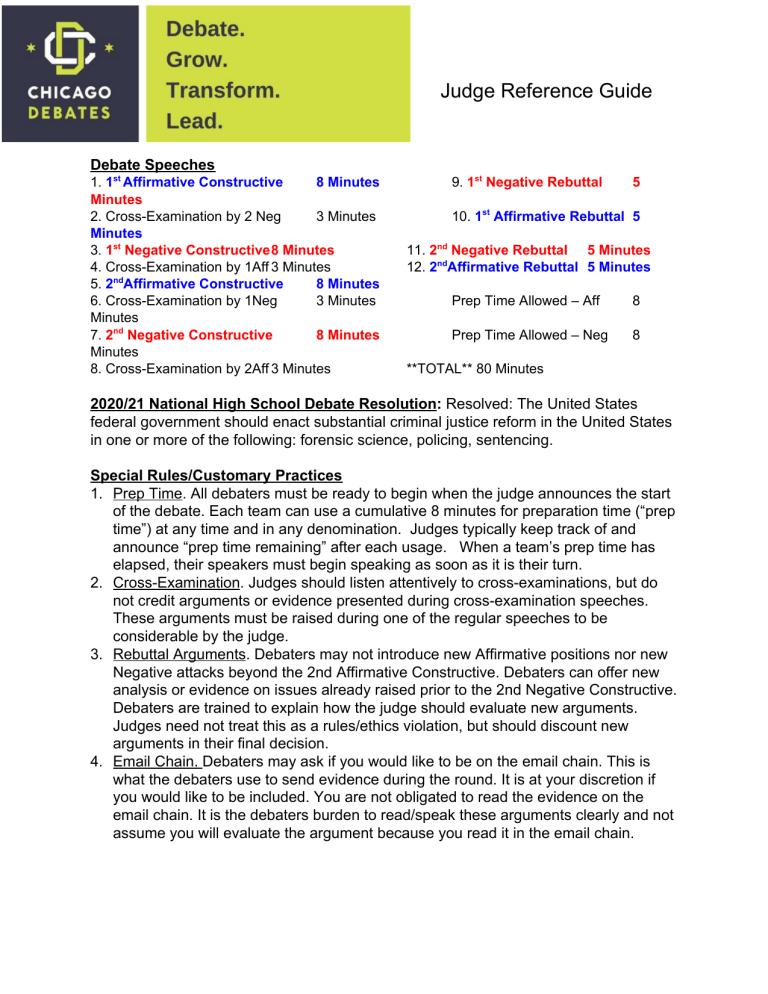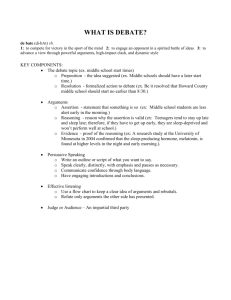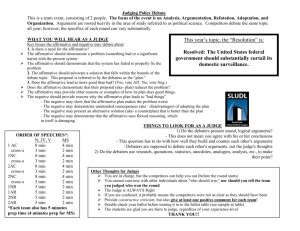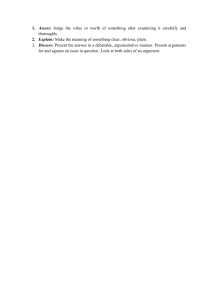
Judge Reference Guide Debate Speeches 1. 1st Affirmative Constructive 8 Minutes Minutes 2. Cross-Examination by 2 Neg 3 Minutes Minutes 3. 1st Negative Constructive8 Minutes 4. Cross-Examination by 1Aff 3 Minutes 5. 2nd Affirmative Constructive 8 Minutes 6. Cross-Examination by 1Neg 3 Minutes Minutes 7. 2nd Negative Constructive 8 Minutes Minutes 8. Cross-Examination by 2Aff 3 Minutes 9. 1st Negative Rebuttal 5 10. 1st Affirmative Rebuttal 5 11. 2nd Negative Rebuttal 5 Minutes 12. 2nd Affirmative Rebuttal 5 Minutes Prep Time Allowed – Aff 8 Prep Time Allowed – Neg 8 **TOTAL** 80 Minutes 2020/21 National High School Debate Resolution: Resolved: The United States federal government should enact substantial criminal justice reform in the United States in one or more of the following: forensic science, policing, sentencing. Special Rules/Customary Practices 1. Prep Time. All debaters must be ready to begin when the judge announces the start of the debate. Each team can use a cumulative 8 minutes for preparation time (“prep time”) at any time and in any denomination. Judges typically keep track of and announce “prep time remaining” after each usage. When a team’s prep time has elapsed, their speakers must begin speaking as soon as it is their turn. 2. Cross-Examination. Judges should listen attentively to cross-examinations, but do not credit arguments or evidence presented during cross-examination speeches. These arguments must be raised during one of the regular speeches to be considerable by the judge. 3. Rebuttal Arguments. Debaters may not introduce new Affirmative positions nor new Negative attacks beyond the 2nd Affirmative Constructive. Debaters can offer new analysis or evidence on issues already raised prior to the 2nd Negative Constructive. Debaters are trained to explain how the judge should evaluate new arguments. Judges need not treat this as a rules/ethics violation, but should discount new arguments in their final decision. 4. Email Chain. Debaters may ask if you would like to be on the email chain. This is what the debaters use to send evidence during the round. It is at your discretion if you would like to be included. You are not obligated to read the evidence on the email chain. It is the debaters burden to read/speak these arguments clearly and not assume you will evaluate the argument because you read it in the email chain. Judge Reference Guide Speaker Points Judges give each debater in a round individual “speaker points.” Speaker points are given on the basis of style, form, presentation, and persuasiveness. A debater may lose the round and still receive high speaker points. Potential criteria to award points: Clarity/Enunciation, Dynamic Tone, Concision, Organization/Structure, Explanation of Evidence, Responsiveness, Comparative Weighing of Issues, Poise, and Respect/Courtesy. Rubric- you can award tenths of a point 30 Points Absolutely brilliant! An outstanding speaker. Flawless performance given the constraints of the round. 29.5 Points An excellent speaker, exceptionally persuasive. All arguments have sound reasoning. Very well organized. Eloquent summary of all arguments. Very little to be improved. 29 Points Very good speaker. Unusually effective rhetoric; highly persuasive. No dropped arguments except for thoughtful or intentional concessions. Very organized. Most arguments are well reasoned. 28.5 Points A good speaker. The reasoning for arguments is sound and persuasive. Well organized speech. Few poor argument choices. 28 Points An effective speaker. No major dropped arguments, but argument choice could be improved. Thoughtful organization, but execution is slightly flawed. 27.5 Points Strengths and weaknesses are nearly balanced; dropping some key arguments but answering other well, somewhat disorganized, some arguments are properly explained while others are not. 27 Points A speaker with strengths, but also with unmistakable flaws (dropping key arguments and poor reasoning for arguments). 26 Points An ineffective and flawed speaker, overall, though with some glimmers of skill. Highly disorganized. Poor Argumentation. 25 Points Punitive for poor conduct such as regular use of profane language or abusive tactics against opponent. Judge Reference Guide Some Conduct Guidelines for New Judges 1. Judge Courtesy. Judges should remain courteous and attentive to debaters, even when the outcome of the debate round seems determined. This includes taking notes or “flowing,” listening to all speeches, and refraining from engaging in outside conversation or activities during speeches. 2. Judge Intervention. Judges should not speak during speeches. A judge will usually speak only to point out basic procedural rules to the debaters (e.g., whose turn it is to speak, how much prep time remains, etc.). Exception for if the debater is speaking too fast. A judge may say “clear” or “slow” to let the debater know they cannot understand them 3. Argument Analysis. Judges are expected to evaluate only the arguments that each debate team has presented and weigh them against the challenges of the other team. Therefore: a. Any argument that is not explicitly challenged is considered to be accepted (or conceded) b. Judges should strive to be impartial and objective. The judge must not inject their own personal beliefs into the debate in support of, or to cover omissions of, the arguments of either team. c. Judges determine the winning team on the basis of the logical arguments and their relative strength – ultimately in a comparison of the policies defended and supported by both sides. Debater demeanor or style should not be a factor in deciding the winner (as that is rewarded in speaker points.) d. The judge must decide a winner solely based on best individual effort to resolve the substantive claims (not on debater demeanor) of the debate. They should not, at any time, ask anyone else for help with their decision. Elimination panel judges should NEVER disclose or discuss how they decide until all judges have independently signed their ballots without discussion. 4. Tournament Director. The judge may seek clarification of any rules or guidelines before rendering a decision, but only from the Tournament Director. 5. Evidence Verification. The judge may ask to see any piece of evidence after the debate. This is done occasionally to assure accurate flowing or when misquoting is suspected. 6. Oral Critique Without Disclosure. To the best of the judge’s ability without disclosing a winning team, the judge should present constructive feedback on how debaters could improve their skills. The feedback should be delivered in an encouraging way, motivating the debaters to seek improvement (as opposed to a harsh criticism of the weaknesses and faults in the students). 7. Presumption- There must be a winner in policy debate. Presumption is the determination of who in the debate round has the burden of proof and thus loses if the team fails to meet that burden of proof. Judge Reference Guide a. In a Case/DA debate the “presumption is Affirmative”- meaning, the Aff has the burden to prove the resolution is a good idea. If the Aff fails to show the plan does anything good, the Neg wins (even if they didn’t say anything.) b. In a Counter Plan or Kritique debate, “presumption shifts Negative”meaning, the Neg has the burden to prove the plan is worse than the CP or alternative. If Neg cannot prove the alternative is better than the plan, the Aff wins (even if they didn’t say anything.) Debate Jargon Glossary: *if a word comes up in a round you are not familiar with, write it down and talk to the Volunteer Manager or Judge Captain about it. Advantage - Benefits which will result from adoption of the affirmative plan. This is usually shown by proving solvency and harm. Card - A single quote from a source which serves to support an argument. The way debate evidence is organized. Cards are segments of larger pieces of text that have been selected to prove parts of our case. We underline and highlight the parts of the card we are going to read in the round but we always leave all of the text so our opponents can see the surrounding context and know it supports our broader point Case Turns - Arguments usually made in 1NC which try to turn an affirmative advantage into a disadvantage. This consists of either 1) a harm turn i.e. proving that the harm occurring in the present system is actually a good thing or 2) a solvency turn. i.e. proving the affirmative will actually increase the harm. Claim - Statement we are trying to prove. Competing Interpretations - A frame for how the judge should evaluate topicality preferred by the negative. It argues that topicality should be treated like any other argument and if the negative wins that their interpretation is even slightly better and the affirmative doesn’t meet it, they should win the round. Conceded/Drop/Dropped - Debaters use this to refer to when their opponents have failed to address (“dropped”) one of their arguments and will argue that their opponents have conceded this point. This means the argument holds true since it wasn’t addressed. Contention/Observation - These are the subdivisions of the Affirmative case (1AC 1st Affirmative Constructive), usually Harms/Advantages, Solvency, the Plan, and Inherency Judge Reference Guide Counterplan - A negative tactic stating that the present system is flawed, but there is a better non- topical solution superior to the affirmative plan and the status quo. The negative team becomes in effect another affirmative team with a case and plan and the obligation to prove certain burdens. Disadvantage (DA) - An off-case position that argues that the Affirmative sets in motion a chain of events that causes bad things to happen and that those things are more important than the Affirmative harms. Often abbreviated as DA or Disad. Disads are made up of four parts: Uniqueness, Links, Internal Links, and Impacts. Extend - Continuing an argument from a previous speech in the next speech. Arguments must be extended from speech to speech to stay active in the debate round and be evaluated by the judge at the end. Fiat - The affirmative right to state that the machinery and personnel will be made available for plan to come into existence. It stems from the fact that we are debating whether the resolution should be adopted, not whether it would be. Flow - A system of notetaking to keep track of arguments in a debate round. These notes also provide the debater with an outline of his or her own speeches. The flow is taken on a flow pad which may be a legal pad. Every competitor and the judge should keep their own flow. Implication - Reason we should care about the claim. In debate it’s much more common for us to use the term “impact” here. Inherency - A barrier preventing the adoption of the plan in the present system. Link - A logical connection between two events i.e. affirmative does A and A causes B. As it is applied to DAs, it is a statement of how the affirmative plan will lead to a disadvantage. Magnitude - How big an impact is. This can be calculated in different ways. It could be size (global warming, for example, affects the entire planet, a war might affect the countries involved and spillover) or it could be the morality of an issue (racism must be rejected). Overview - A summation given at the beginning of the 2NR and the 2AR speech which is 30 second - 1- minute long which tells the judge why the team is winning the round and what issues are important Judge Reference Guide Plan - the Affirmative’s federal policy for change, meant to address the problems (Harms) of the world now. This is presented in the 1AC, the 1st Affirmative Constructive, and will often sound like the text of a bill in Congress that’s read aloud in the first speech as the focus of the rest of the debate Probability - The likelihood that an impact will occur. In the case of systemic/structural impacts that are happening now that is 100% (think racism, sexism, poverty) in the case of something like a war it is dependent on the internal links and other conditions that influence whether we will reach the brink (tipping point). Reversability - An argument made by debaters in Impact debates about how the consequences of their arguments are more permanent than that of their opponents’ arguments. For example, economic recession is likely something we can recover from, but global warming or nuclear winter might not be. Scope - A subset of magnitude that looks at the breadth of the issue. For example, if we compare a small regional war and a great power war the scop Signposting - A verbal signal from a debater during their speech that they are ready to move on to the next issue. Solvency - Proof that the Affirmative plan will solve the harm to gain an advantage over the present system. The Chicago Debate League Approach The primary goal of CDL debates is debater education; competition is a secondary, though an important, goal. CDL debaters bear the burden of arguing so that the judge can understand their points, adapting to the knowledge and skill level of the judge. The debaters are expected to speak at an understandable speed and explain their argumentation logic clearly. If the judge fails to hear or understand points, the debaters (not the judge) are at fault. Judge Reference Guide Advanced Debate Analysis:* *You will not need to understand all of these intricacies but we provide them as reference The 4 Parts (Contentions) of the 1AC The 1AC will read like a mini story: here is what is happening in the status quo with regard to one issue, here is why that’s bad, here is how the plan will prevent that specific outcome. 1.Inherency- Description of the status quo in which the plan is not happening right now 2. Harms/Advantage- Explanation of why the plan is necessary. Why it is bad we are not doing the plan and what will happen as a result of the current SQ if the plan is not enacted? 3.Plan- Affirmative option that falls within the resolution that intends to solve the harms. 4.Solvency- How the Plan prevents the harms. This will usually include an explanation of the mechanism it uses to carry out the plan. Note: The information given in Solvency is necessary, however it can come at the end of every harm/advantage and may not be labeled independently. Components of a Well-Argued Disadvantage (“Disad” or “DA”) The DA will read like a mini story: here is what is happening in the status quo, the plan changes the status quo causing a chain reaction of events, something bad happens as an end result. 1. Uniqueness: Description of the Status Quo in which everything is fine. The DA is direct result of implementing the Affirmative plan (so the impact cannot be occurring absent adoption of the Plan). 2. Link: How the plan directly changes the status quo to cause negative side effects 3. Internal Link: How the side effects of the plan lead to other negative results (“Impacts”) 4. Impact: The very bad thing that happens as a result of doing the plan. Components of a Well-Argued Topicality Attack (“T”) The Affirmative Plan must be representative of this year’s resolution in order to win the round. The Negative will argue that the Plan does not meet this year’s resolution so the judge should not vote for it. 1. Definition. How the Neg defines a specific word or phrase in the resolution 2. Violation. How the Aff defines that same word to violate (not fall within) the intent of the resolution. 3. Standards. Justification for why the Negative’s interpretation of the meaning of the word or phrase is superior to any potential Affirmative interpretation. Some common Negative Standards are: Judge Reference Guide a. Ground. The Affirmative plan is too broad or too narrow for the Negative to anticipate and/or to attack with specific evidence. b. Limits. The definition provides a reasonable sized topic that allows for enough viable Aff cases but not so many that the Neg cannot prepare. 4. Voting Issue. Justification for why the judge should consider topicality important enough of an issue for it to be a deciding vote, such as preserving education, fairness, or judge jurisdiction. Components of a Well-Argued Counter Plan Attack (“CP”) The Negative will propose a different policy option (that usually solves the harms laid out by the Affirmative’s 1AC) for the judge’s consideration as an alternative to the plan. 1. Counter Plan Text. A Neg policy option that attempts to correct the status quo. 2. Solvency. Description of how the counter-plan solves the problems/harms laid out by the affirmative, and how the counter plan solves the problems of the 1AC potentially better than the Aff’s plan. 3. Net Benefit- What the Counter Plan does additional to the plan to make it a superior course of action.



